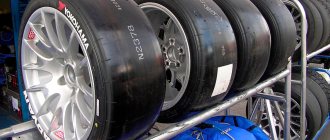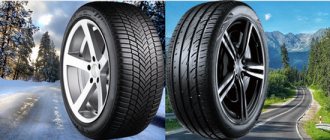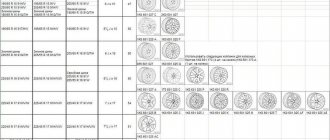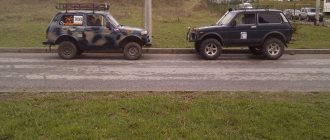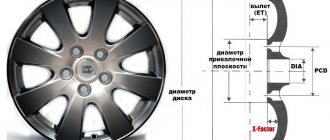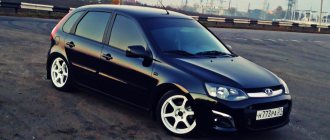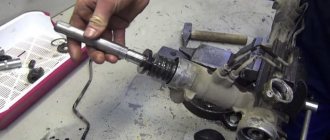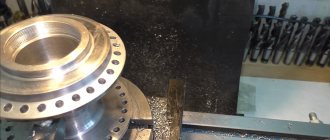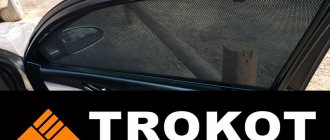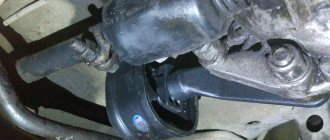Thanks to the wheels, the car has the ability to move along the road. They are supplied with rotation from the engine through the transmission, and due to frictional forces the wheels are pushed off the surface, and the car moves.
Car wheels consist of two components - a tire and a wheel. The main working element of the wheel is the tire, or otherwise the ramp, and the disk acts as a seat for it, and also provides fastening of the wheel to the hubs.
Tires provide:
- Road grip;
- Smoothing out minor road irregularities;
- Ability to move on surfaces with different characteristics;
- Car controllability.
Also, noise during movement depends on these elements.
Internal organization
The structure of a car tire is complex, despite its simple appearance. In cross section, the slope has a C-shape, which is formed by a number of layers.
One of the bus schemes
These layers have their own name:
- cord frame;
- breaker;
- tread.
Additionally, a substrate can be used between the last layers.
The cord carcass is the basis of the tire. The basis of the frame is cord - rubberized layers of threads (cotton, viscose, nylon, steel wire) covering the entire area of the frame and arranged in a certain way. The frame may consist of one or several cord layers.
Based on the arrangement of the carcass threads, tires are divided into diagonal and radial. In the first case, a cross arrangement of cord layers is used. In radial tires, the threads run perpendicular to the direction of rotation of the wheel. Diagonal tires are now practically not produced.
The breaker is another layer of cord, but it is not located over the entire area of the frame, but only on the working surface. In addition, the breaker uses stronger threads, which increases the strength and resistance of the frame to damage. In essence, the breaker acts as a reinforcing connecting layer between the frame and the tread. The breaker cord threads are positioned exclusively diagonally.
The tread is the outer working part of the tire. It is a fairly massive rubber layer made of high-quality materials and with a printed pattern formed by depressions in the rubber. This pattern is called the “treadmill”, which is in contact with the road. The tread not only provides the necessary grip on the surface, it also acts as a protective layer that protects the frame from damage. The type of pattern applied to the tread affects the traction qualities of the tire and divides them into road, universal, and all-terrain.
Radial, diagonal and steel cord
Strength properties are determined by the material and location of the cord threads. Gradually, a unified approach to design was developed - road tires, including those operating at high speeds, must have a radial weave of metal threads, which ensures minimal lateral wheel slip while maintaining comfortable absorption of irregularities. And rubber for cars operating in more difficult conditions and at lower speeds requires high strength while maintaining some profile flexibility, hence the use of somewhat outdated diagonal weaving and textile nylon cord. Moreover, multi-layered, the strength needed is really high.
The sidewall of bias-type tires does not resist lateral slips well, that is, deviations of the plane of rotation from the trajectory in turns, but due to the crossing of the cord threads it perfectly resists damage from impacts.
External device
If we consider the structure of a car tire only from the outside, then it consists of:
- sides;
- sidewalls;
- shoulders;
- treadmill.
The beads ensure a secure fit of the tire on the rim. The rigidity of these elements is provided by power rings made of metal wire, fused into the frame around the circumference. When looking at the cross section of a tire, the beads are the peaks in a C-shape.
The sidewalls extend from the sides - the side parts of the frame, coated with an additional protective layer of rubber that prevents damage to the cord frame.
The shoulders provide the transition from the sidewalls to the treadmill. In addition, when deformed (when hitting an obstacle, entering a turn), the shoulders take part in providing traction with the road.
The treadmill, which is the main working surface, approaches the shoulders, so it has the most multi-layered structure.
In cross-section, the tire structure is as follows: there are two beads connected to two sidewalls, which go to the shoulders, and those go to the edges of one treadmill, which forms a C-shape.
Main components
A modern bicycle includes two wheels, usually of the same diameter. The rear wheel is usually the drive wheel and is driven by a bicycle chain.
A wheel consists of a hub, spokes, rim, tube and tire. Sometimes the tube and tire are one unit, that is, a tubeless tire.
The hub is connected to the wheel rim using spokes, the number of which ranges from 12 to 48. Prestigious models of bicycles with a frame made of composite materials are often equipped with wheels whose spokes are made of carbon.
The size of a bicycle wheel is traditionally determined by the outer diameter of the tire in inches - from 14 to 29 (1 inch = 2.54 cm). A mountain bike usually comes with 26-inch wheels, while a hybrid or touring bike has 28-inch wheels.
The rear wheels of sports bicycles do not contain spokes, so they consist of a solid disk. This design increases wheel rigidity and reduces oncoming air resistance at high speeds. The only drawback is the increased windage, which adds trouble to cyclists in crosswinds.
Rim
Material
In the manufacture of bicycle wheel rims, steel or aluminum alloys are used in most cases. Steel rims are cheaper, but heavier and more susceptible to corrosion. In recent years, lighter composite materials have been increasingly used: carbon and plastic.
New technologies make it possible to spray ceramics onto the braking surface of rims. This not only shortens the braking distance of the bicycle in wet weather, but also extends the service life of the wheel.
Bicycle wheel spoke
A very vulnerable element. In addition to the load from the weight of the cyclist, it is subject to impacts on uneven roads. Using a nipple, the spoke is fixed in the rim. The most common knitting needles are made of steel or aluminum.
The spoke consists of four parts:
- Head. The head is fixed to the sleeve.
- Body.
- Thread. A nipple is screwed onto the thread.
- Nipple. The nipple attaches the spoke to the rim.
The nipple must be made of the same material as the spoke.
To evenly distribute the load and avoid rim distortion, the tension of the spokes should be the same. This corresponds to an optimal balance between structural elements. Types of knitting needles:
- Rolled knitting needles are a budget option.
- A drawn knitting needle is lighter in weight, but more expensive.
- The flat knitting needle is the most expensive, significantly superior to other types both in weight and in resistance to oncoming air flow.
Spitsovka
Spoking is the order in which the hub, spokes and rim are mutually attached. There are two main types of wheel spokes: “radial” and “cross”.
In the “Radial” view, the spoke does not intersect with the others. When assembling with a “cross”, the knitting needle crosses with the other knitting needles several times, depending on the chosen knitting method. On widely used 26-inch wheels, three-cross spokes are more often used.
Types of rear bicycle hubs, their differences from each other
The hub is the base of the wheel.
The hub is located in the center of the wheel and rotates on bearings. As bearings, collapsible balls or factory-made universal sealed bearings are used. The bearing bears all the pressure of the bicycle when riding, so its quality must be high.
The hub is connected to the wheel rim through spokes. Outdated models of “Torpedo” type hubs contain a brake drum inside the structure, with the help of which the cyclist brakes by reverse rotation of the pedals.
A modern bicycle rear hub includes a ratchet mechanism and a cassette with chainrings that fits onto the drum. On a freewheel hub, the bearings are located closer to the center, so the load is not distributed evenly. Hubs of this type are installed on teenage or budget adult bicycles.
The cassette hub is another popular type of rear hub. It has slots on which the cassette with stars is mounted and secured with the cassette nut. These hubs are more reliable, the bearings are located further from the center of the hub, so the bike can support up to 120 kg.
The third type of rear hubs is a hub with a planetary gear shift system. It combines the functions of a hub and a bicycle gear shift mechanism.
The entire mechanism is located inside the bushing and is protected from dust and moisture. The chain on a bicycle with such a bushing lasts longer, as it does not change its position. The planetary bushing has a high degree of reliability.
The design of the SRAM 3-speed planetary hub is very simple. But it’s better not to disassemble the 5 and 7 speed ones. Planetary gears are installed in a special position - this requires a special tool.
Classification
There are several criteria by which car tires are divided:
- Method of sealing the internal space;
- Seasonality of use;
- Tread type;
- Scope of use.
All these criteria are quite important and are taken into account when choosing tires.
Sealing method
Based on the sealing method, existing types of tires are divided into tubed and tubeless.
In chamber air, providing the necessary pressure inside, is pumped into a special rubber cylinder - a chamber. The main disadvantage of such wheels is the ease of damage, since even a minor puncture of the tube will lead to a flat tire. But on the other hand, bending of the disc rim under strong shock loads does not lead to flattening. On passenger cars, the chamber type is now used very rarely.
In tubeless tires, air is pumped into the space formed by the inner surface of the tire and the rim. They are less “sensitive” to punctures and can withstand up to 7-8 punctures (provided that the element that punctured the tire remains in it). But even a slight bend of the rim will cause the bead to “peel off” and the wheel will bleed air.
Seasonality of use
Based on the season of use, tires are divided into summer, winter and all-season. The differences between them come down to the material of manufacture (summer ones use hard rubber, and winter ones use soft rubber), the shape of the pattern and the tread depth. The all-season option is intermediate, and does not provide proper grip either in winter or summer. The optimal period for using such rubber is early spring and late autumn.
Tread type
According to the type of tread, the types of tires are road, all-terrain and universal. The first ones are designed for use on hard surfaces. All-terrain tires are characterized by a deep tread and pronounced lugs, providing excellent driving performance on rough terrain. Universal wheels are suitable for both on-road and off-road driving, but not very much, since they have lugs, but they are not very “powerful”.
Scope of use
Depending on the area of use, tires can be general purpose or sports. All types of general purpose tires have a certain profile height to width ratio, which provides the necessary volume for air injection.
Sports tires include low-profile tires, slicks and semi-slicks. Low-profile ones have a low sidewall height. But to ensure the required volume for air injection, the designers increased the width of the tires. As a result, the contact area of the treadmill has increased, so low-profile tires have improved traction. They are intended for driving only on hard surfaces. Due to the presence of a tread, their use on public roads is allowed.
Slicks are exclusively sports tires. Their feature is the complete absence of a tread pattern, which ensures maximum contact between the wheel and the road. They are used only on dry hard surfaces.
Semi-slicks differ from slicks by the presence of a small tread in the central part of the treadmill, but there is no pattern on the surface at the edges. Despite the existing tread, such tires cannot be used on general roads; they can only be driven on auto tracks.
The most common problem associated with tires during car operation is punctures, as a result of which the air from the wheel escapes and further operation is impossible.
This problem was partially solved with the advent of tubeless tires. As already indicated, they are able to withstand a certain number of punctures.
Tread pattern and material
Road grip and long-term durability are determined by the pattern and composition of the rubber compound. Harder rubber has durability, but holds the road less confidently. Soft tires are prone to overheating and wear out quickly, but grip the road better at the same internal pressure. A compromise is sought for any specific conditions, especially for seasonal tires. Winter ones are always softer, since any mixture changes its properties depending on the temperature.
Only road racing drivers can do without a tread pattern. But even in rainy conditions, they use tires with grooves to drain water. In civilian use, the protector is needed to work on contaminated surfaces and slippery surfaces. For SUVs it turns into a set of large lugs, and for winter tires it turns into small lamellas with sharp edges.
Flat technology
Attempts to solve this problem led to the emergence of so-called “puncture-free” tires, also known as Run Flat tires.
There are two run flat technologies used on cars. The first of them is strengthening the sidewalls. Due to the increase in the rigidity of the sidewalls, when air is released, the weight of the car begins to be supported by the sidewalls. Thanks to this technology, a wheel without air can travel up to 100 km at a relatively good speed of up to 80 km/h.
Run flat technology
The second technology is the use of a support ring. This ring, made of high-strength plastic or metal, is installed and fixed on the rim inside the tire. In the event of a tire puncture, when the air is released, the wheel begins to rest on the ring, which allows you to continue driving without possible damage to the disc. Despite the fact that the ring is made of hard materials, the noise when driving does not increase much, since there is always a layer of rubber between the road and the ring.
Run flat technology really solves the problem of punctures. But in the case of wheels that have reinforced sidewalls, they will not help if the sidewall is severely cut. But wheels with a support ring are expensive and require specialized equipment for maintenance.
It is worth noting that Run Flat is a general designation for puncture-free tire technology. Manufacturers often use their own designation for such rubber, which creates some confusion.
Additional tire marking parameters
- Winter - winter tires.
- A pictogram in the form of a snowflake - tires are marked for use in harsh winter conditions.
- Aqua, Rain, Water, Aquatred, Aquacontact, etc. (or umbrella pictogram) - indicates that the tires are effective on wet roads.
- AS, All Season or AGT (All Grip Traction) - designation of all-season tires
- AW or Any weather - all-weather
- M+S (Mud+Snow) or M&S - mud and snow, winter or all-season tires are specially designed to improve vehicle handling when driving in mud or snow (in slush, not to be confused with winter use - for this it is better to choose tires marked 3SMPF ( details below).
At the end of the marking there may be an “ E ” - studded tires.
- If the tire sidewall does not have the above-described markings, then this tire is intended for use only in summer conditions.
- All-Terrain is a designation for all-terrain tires with universal properties intended for SUVs.
- Max pressure — The maximum permissible pressure, measured in kPa.
- Max Load - The maximum permissible load on a tire, measured in kg (or British pounds).
- ROTATION with a directional arrow – applied to tires with a directional tread pattern, indicating the direction of rotation of the tire.
- FRT = Free Rolling Tire: This tire can only be installed on a trailer axle or free rolling axle and cannot be installed on a steering or drive axle.
- HCT = Hot Climate Technology: A tire with specific characteristics for working in countries with hot climates.
- DOT – compliance with US standards. The US Department of Transportation requires tire manufacturers to evaluate tire quality [Tire Quality Classification], with the exception of winter tires. This code identifies the company and factory, soil, batch, and production date (2 digits for the week of the year plus 2 digits for the year; or 2 digits for the week of the year plus 1 digit for the year for tires made before 2000).
- E in a circle - tires that meet ECE (Economic Commission for Europe) requirements are marked. The number indicates the country of approval.
- Reinforced (or the letters RF at the end of the size) - indicate that the tire is reinforced, used for vehicles with increased load capacity, and has 6 layers. The letter C in the size designates a truck tire with 8 layers.
- XL (Extra Load) – reinforced tire.
- Radial – tire of radial design. The same as the letter R in the standard size. Steel (steel belted) - this means that the tire structure contains a metal cord.
- Outside, Side Facing Out – the outer side of a tire with an asymmetric tread pattern. During installation, the word Outside must be on the outside of the machine.
- Inside, Side Facing Inwards - the inner side of the tire with an asymmetric tread pattern. During installation, the inscription Inside must be located on the inside of the machine.
- Retread - restored;
- Plies – tire design features – Tread area: – tread layer composition; Sidewall: – composition of the sidewall layer.
Tubeless or TL – marking of tubeless tires. The absence of this marking indicates that this tire can only be used with a tube. Tube Type, TT or MIT SCHLAUCH - the tire must be used only with a tube. Parameters reflecting the quality of tires, according to the American UTOG tire quality classification system: Traction A, B or C - the coefficient of adhesion to the road surface or the tire’s braking ability. Takes on the values A, B, C. Coefficient A means the highest value of adhesion in its class. Temperature A, B or C is an indicator characterizing the heat resistance of the tire. Possible values are A, B and C. Indicator A is the best Treadwear 200 - wear resistance coefficient, determined in relation to the base tire (it has a value of 100) of a particular manufacturer. Obtained as a result of standardized tests in the USA. TWI (tread wear index) or TWID - indicates the location of the projector wear indicators, protrusions at the bottom of the tread grooves. When the tread wears down to the level of these indicators, the tire is considered unsafe to operate and it is time to replace it. Date of manufacture of the tire (four digits, enclosed in an oval or rectangle with rounded corners) - the first two digits indicate the serial number of the week in the year, the next two the year of manufacture. DA (stamp) - minor manufacturing defects that do not interfere with normal operation are indicated. The tire also indicates: • Trademark, manufacturer's name • Trademark (tire model). • Made in... – name of the country of the tire manufacturer. FB – (Flat Base) – marking of tires without rim protection. FR – (Flange pRotector) – marking of tires with rim protection. Green X, Reduces CO2 - designations for tires with low rolling resistance, indicate fuel savings due to the use of such tires. RunFlat, RunOnFlat, HP, SSR, SST - designations indicating that these are emergency tires, making it possible to continue driving even when the tire is flat. RPB (Rim Protection Bar) or MFS – (Maximum Flange Sheild) – protects the rim from damage from curbs and sidewalks.
"Self-healing tires"
But there is another technology for “puncture-free” tires – “self-healing”. It does not apply to Run Flat.
The essence of this technique comes down to applying a special viscous material to the inner surface of the tire. In the event of a puncture, it clogs the resulting hole and prevents air from escaping. This technology is the simplest and at the same time the cheapest. The cost of tires with such an internal coating is practically no different from regular tubeless tires.
By the way, on the car accessories market you can now find special compounds that make it possible to make “self-healing” tubes out of ordinary tubeless ones. And to do this, it is enough to pump the compound inside the wheel through the valve, and during operation, the filled material spreads evenly over the inner surface of the tire, the disadvantage of this method is that the entire inner surface of the disk will be covered with this compound.
Wheel profiles
About the design and operation of a car How to inflate a car wheel with a compressor. How to inflate tires correctly
For the rational interaction of wheels and the rail track, the shape of the rolling surface – the wheel profile – is important. On (Fig.
5, a) shows the standard tread surface profile that the wheel has after turning. This profile is characterized by a ridge height of 28 mm and a thickness of 33 mm measured at a distance of 18 mm from the apex, a conical tread with tapers of 1:10 and 1:3.5 and a chamfer of 6 x 6 mm.
Rice. 5 – Rolling surface profiles: a – standard; b – recommended by VNIIZhT
The ridge, which protects the wheelset from derailment, has an inclination angle of the outer edge of 60°. The conical surface, in contrast to the cylindrical one, prevents the formation of wear (rolling) that is uneven across the width of the wheel, facilitates the passage of curves and centers the wheel pair in straight sections of the track. However, due to the conical shape of the rolling surface, a tortuous movement of the wheelset appears, which is studied in the course “Wagon Dynamics”. With the surface located at the outer vertical edge, the wheel less often rests on the rail, so it wears out less than the main contact surface. Due to the presence of a 1:3.5 taper and a chamfer, the outer edge of the wheel is raised above the rail head, which facilitates the passage of turnouts in the presence of rolled metal or an influx of metal on the wheel.
Since the wheel has a conical surface, its diameter, rolled size and rim thickness are measured in a certain plane - along a rolling circle located at a distance of 70 mm from the inner edge of the wheel. The distance between the rolling circles of wheels on broad gauge railway cars is 1580 mm with a nominal size of 1440 mm.
VNIIZhT proposed a new profile of a car wheel (Fig. 5, b). Experiments have shown that wheels with this profile have 1.2–1.3 times less flange wear. Increasing the angle of inclination of the outer edge of the ridge to 65° increases traffic safety (stability of the wheelset on the rails). For example, when traveling at a speed of 55 m/s (200 km/h), the safety factor against derailment increases by 30%.
A similar wheel profile has been introduced in a number of European countries. In this case, the angle of inclination of the outer edge of the ridge is increased to 70°. According to research by the International Union of Railways, thanks to the use of a new profile, wheel wear is reduced by 30%, the likelihood of derailment is reduced (at high speeds by 1.5 times), and the smoothness of the ride is improved. According to British researchers, the mileage of wheelsets without turning the rolling surface increases by 50% compared to wheels of the previous profile.
Improving the smoothness of the ride by reducing the frequency of wobble oscillations, especially significant at high speeds, is also achieved by replacing the 1:10 taper with a 1:20 taper. Wheels with this taper are used for high-speed carriages in Japan and in a number of other countries, and in France and Switzerland for all passenger carriages. The wheels of some railway cars in our country have a taper of 1:20, which are subject to increased requirements for smooth running.
The transition to a new wheel profile is associated with the need to modernize wheel lathes and measuring instruments. In addition, when turning worn wheels, you may have to remove thick chips. Research to improve the wheel profile continues.
